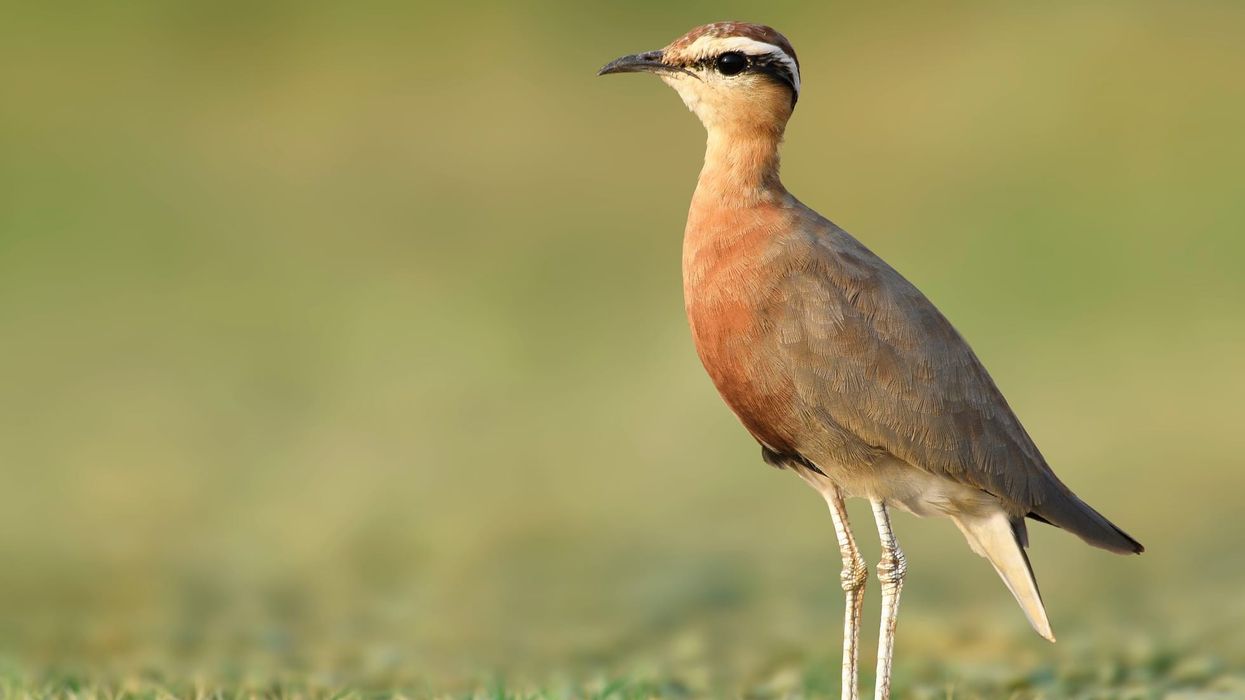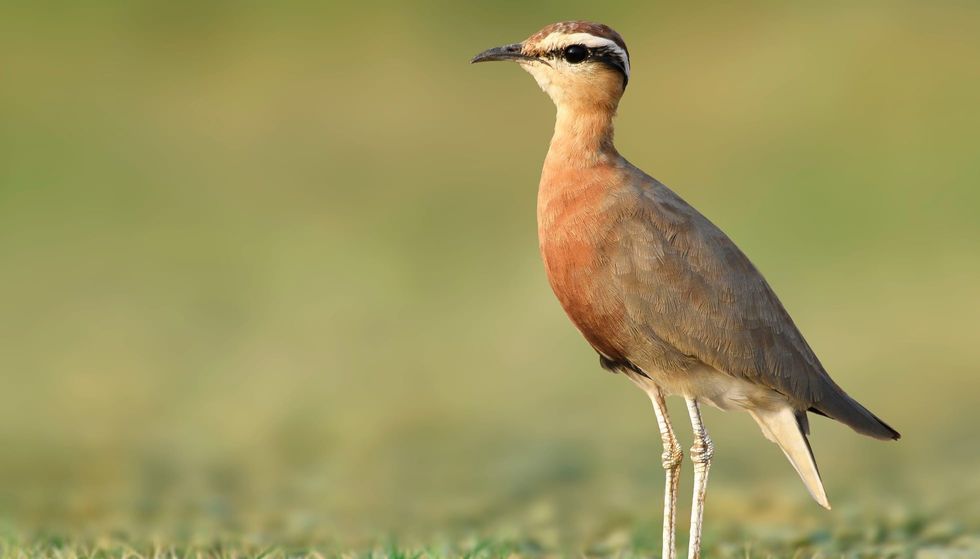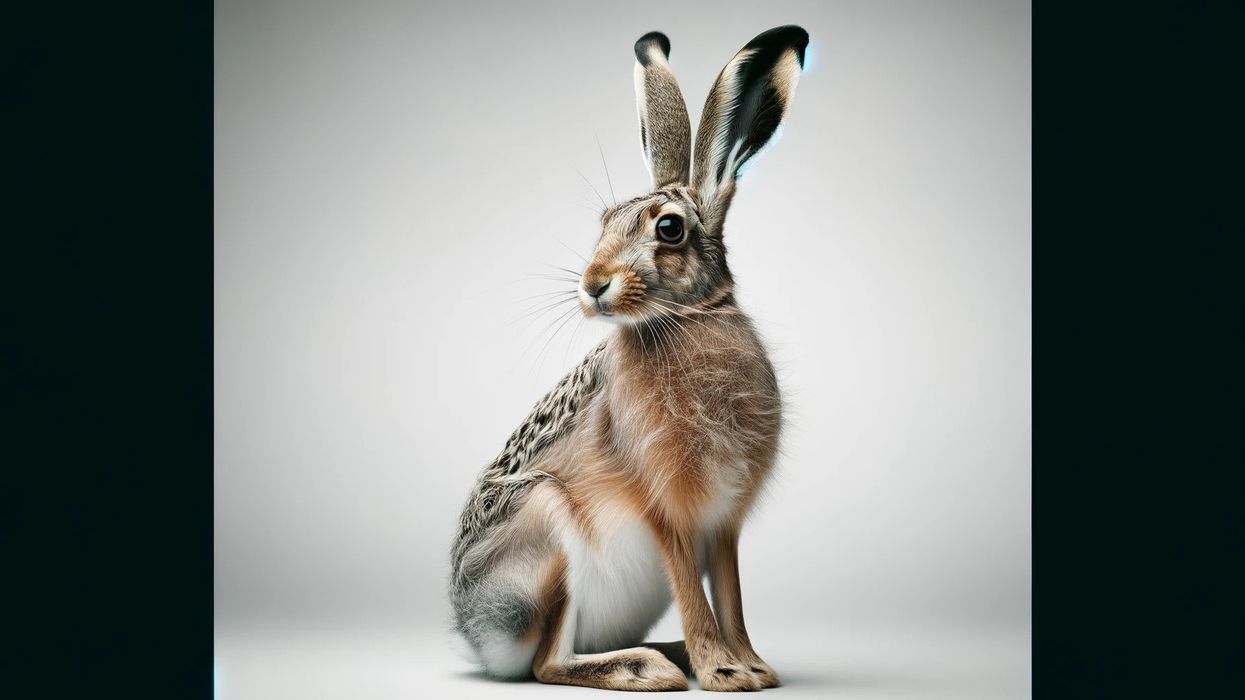The Indian courser (Cursorius coromandelicus) is one of the many birds whose distribution is dense in India - that was obvious, wasn't it? Well, what isn't obvious from its name is that this species is also found in places such as Sri Lanka and Sub-Saharan Africa.
In India, the population of these birds is found everywhere, but particularly in places such as West Bengal, Maharashtra, and Kerala.
This bird species belongs to the order Charadriiformes which is the same as the plover bird. They have a dark brown or gray colored upper body, cream colored breasts, and rufous colored underparts. One of the most distinctive features of this bird species is the black stripe that runs across their eyes.
These birds are a ground species which means that they do not take frequent flights. When they do take flights, the height that they reach is small. They also make their nests in the ground and not on trees, as opposed to many other bird species of the world.
The breeding season in this species starts in March and continues until August, during which, the female Indian courser lays around two to three eggs in each clutch. The nestlings are capable of running around with their parents right from hatching.
One of the fun facts about the Indian courser is that this species is not migratory and is endemic to India.
For more relatable content, check out these palm warbler facts and great-tailed grackle facts for kids.
Indian Courser Interesting Facts
What type of animal is an Indian courser?
The Indian courser (Cursorius coromandelicus) is a species of birds that is endemic to South Asia, particularly India.
What class of animal does an Indian courser belong to?
In scientific terms, the class that this species belongs to is Aves. However, in more popular language, the class that we associate the Indian courser (Cursorius coromandelicus) with is birds.
How many Indian coursers are there in the world?
There is no study that can tell us the exact number of C. coromandelicus that there are in the world, however, the conservation status of this species suggests that the population of this bird faces no immediate threat of extinction, neither is their habitat facing any serious damage.
Where does an Indian courser live?
The Indian courser species lives in shrublands, rocky and dry areas, as well as along riverine shores. Such habitat ensures that they are supplied with ample insects to feed on.
What is an Indian courser's habitat?
The Indian courser range map runs almost throughout the country of India, particularly in places such as West Bengal, Maharashtra and the South Indian states of Kerala and Karnataka. These birds are also found in parts of Sri Lanka and Pakistan. Places in Bangladesh and Sub-Saharan Africa also have small populations of this bird species.
Who do Indian coursers live with?
The Indian courser bird species is known to prefer living in small flocks. This species is not a loner, however, some birds sometimes stray away from their range map in order find food and a better habitat.
Such cases are very rare and if you happen to see an Indian courser (Cursorius coromandelicus), chances are that more birds of the same species or other related species such as Cursorius cursor and Cursorius rufus are somewhere in the proximity.
How long does an Indian courser live?
The average lifespan of Indian courser birds is not known.
How do they reproduce?
This species is oviparous which means that they lay eggs. Their breeding season is between March and August and the female Indian courser lays about two to three eggs in a single clutch. Eggs are laid in nests that are made on strips of dry land.
Soon after the nestlings hatch, they are ready to run on the ground with their parents in search of food. The babies are fed by the male and female Indian courser parents for a week, before they fledge and are able to find their food by themselves.
What is their conservation status?
According to the IUCN, the conservation status of this ground bird species is Least Concern. This means that the Indian courser (Cursorius coromandelicus) population or habitat are set to face no threats in the near future.
Indian Courser Fun Facts
What do Indian coursers look like?
The Indian courser (Cursorius coromandelicus) is a beautiful and colorful courser from the order Charadriiformes. These birds have a dark brown or grayish colored crown, and a pale cream colored breast. The brown color on the upper side of their body runs through to their tail and gives them a look that is typical to the courser family.
One of the features that help us in spotting an Indian courser is the black patch or black stripe that begins at the base of their beak and runs throughout their eye. Their body turns from pale cream to a vibrant rufous color at the south-most part of their abdomen, right below the breast.
The pattern of the coloration on their body makes them truly spectacular.
This courser bird species is a member of the superspecies that contains Cursorius cursor, Cursorius rufus and cursorius temminckii.

How cute are they?
With their colorful body, black eye stripe and adorable long wings, it is safe to say that the Indian courser (C. coromandelicus) is a very cute bird species and an absolute treat to the eyes.
How do they communicate?
The Indian courser has a rather low-pitched call which it uses it order to communicate with its mates. They mostly let out this call when they are taking a short, low flight.
How big is an Indian courser?
This bird species of the order Charadriiformes is a medium-sized courser. They are 12 in (30 cm) tall. Most of their height comes from their legs which are tall enough for them to scour through grass or ground for insects and other such prey.
It is also interesting to note that this species can be almost twice as big as a plover bird.
How fast can an Indian courser run?
While we do not know the speed that these birds of the Glareolidae family can run at, it is likely that they are fairly fast since they race at the speed of lightning whenever there is prey in sight.
How much does an Indian courser weigh?
The Indian courser (Cursorius coromandelicus) have a weight of around 0.28-0.34 lb (130-158 g). This makes them considerably heavier compared to other bird species of the world. Such a weight, though, is justified since they only take low flights and are a ground bird species.
What are the male and female names of the species?
There are no distinct names for male and female Indian coursers. We will simply have to refer to them as the male Indian courser and the female Indian courser.
What would you call a baby Indian courser?
Like in the case of other Aves, Indian courser babies are called nestlings. They are called this until they are bound to their nests.
What do they eat?
These courser birds from the country of India have a strictly insectivorous diet. They scour the ground on foot in search of food and ingest it with the help of their bill. Their habitat and distribution means that insects such as termites, click beetles, mole crickets and grasshoppers are easily and abundantly available to them.
Are they dangerous?
The Indian courser (Cursorius coromandelicus) are a pretty harmless species. They live in small groups which also suggests that they are have an amiable nature. There are no instances when this species was seen to have caused harm to any humans.
Would they make a good pet?
It is unlikely that this bird would make for a good pet because their habitat and dietary requirements would be difficult to fulfil. Their habitat and distribution in India has habituated them to rocky areas as well barren ground, and a cage atmosphere will be harmful to them.
Did you know...
The Indian courser is a part of a superspecies that also contains Cursorius cursor, Cursorius rufus and Cursorius temminckii.
The Jerdon's courser was considered extinct as it had not been seen since Thomas C. Jerdon discovered this bird in 1848. However, it was spotted again in 1986.
Do Indian coursers migrate?
Indian coursers are not a migratory species. The temperature and other climatic conditions in India and Sub-Saharan Africa do not require them to seek warm areas.
How many eggs do Indian coursers lay?
The breeding pattern of the Indian courser means that they lay two to three eggs in each clutch. The season in which they breed ranges between March and August.
Here at Kidadl, we have carefully created lots of interesting family-friendly animal facts for everyone to discover! Learn more about some other birds from our carrion crow facts and corncrake facts pages.
You can even occupy yourself at home by coloring in one of our free printable Indian courser coloring pages.








